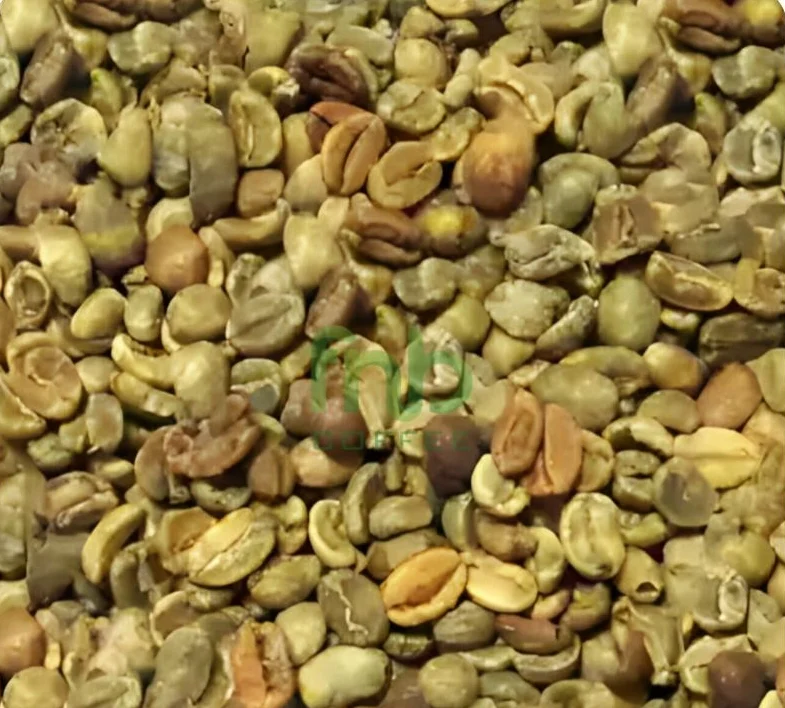Past Crop
Characteristics
- Fragrance/Aroma: Fresh, Nutty
- Flavor: Rich, Earthy Body, and Very Little
- Acidity: Good Acidity
- Body: Medium to High or Full-body (Rich)
- Origin: Batak Highland/Gayo Highland
- Moisture: Max 13%
About Coffee Past Crop
Past crop coffee refers to green coffee beans that have been stored beyond their optimal freshness period, typically from a previous harvest season. As coffee is an agricultural product, its quality can degrade over time, especially if storage conditions are not ideal. This degradation can lead to diminished flavors and aromas, making past crop coffees generally less desirable than fresh ones.
Though the these coffee beans can still be roasted and brewed into coffee, there are some aspects to consider:
- Aroma and Flavor: The quality of the coffee beans tends to diminish as they age, resulting in a less potent aroma and a less rich taste compared to fresh coffee beans.
- Loss of Nutrients: Past-crop coffee beans may have lost some of their nutrients and natural compounds during the extended storage period.
- Lack of Brilliance: Fresh coffee beans usually exhibit brightness, roundness, and bright green color. However, past-crop coffee beans may have a less appealing appearance and could be drier.
- Lack of Uniformity: After an extended storage period, past crop coffee beans might display uneven sizes and shapes, which can impact the final result after roasting.
Flavor and Aroma Changes
The most noticeable difference in past crop coffee is its muted flavors and stale aromas. Instead of the vibrant, fruity, or floral notes of fresh coffee, past crop beans may develop musty, hay-like, or even woody characteristics. These changes occur due to oxidation and the gradual breakdown of organic compounds in the beans.
Appearance and Physical Changes
Past crop coffee beans often show visible signs of aging. They may appear faded, discolored, or have a rougher texture compared to fresh beans. This is a result of prolonged exposure to air and humidity, which can cause the beans to lose moisture and essential oils that contribute to their taste.
Uses of Past Crop Coffee
Despite its decline in quality, past crop coffee is still useful in certain applications. Many roasters blend it with fresher beans to maintain affordability while preserving some level of flavor complexity. Some businesses use past crop beans for instant coffee, flavored coffee products, or lower-cost retail offerings.
How to Store Coffee to Prevent Aging
Proper storage can slow down the aging process and extend the usability of coffee beans. Green coffee should be stored in a cool, dry environment with minimal exposure to air and humidity. Vacuum-sealed bags or grain-pro storage systems help maintain freshness for longer periods.
$17 – $30Price range: $17 through $30
Description
Characteristics
- Fragrance/Aroma: Fresh, Nutty
- Flavor: Rich, Earthy Body, and Very Little
- Acidity: Good Acidity
- Body: Medium to High or Full-body (Rich)
- Origin: Batak Highland/Gayo Highland
- Moisture: Max 13%
About Coffee Past Crop
The Green Coffee Beans Past Crop product is composed of unroasted green coffee beans that have surpassed the standard storage period and are likely to have decreased in quality compared to fresh coffee beans. These green coffee beans have gone beyond their optimal storage duration and may be of lower quality than newly harvested ones.
Though the these coffee beans can still be roasted and brewed into coffee, there are some aspects to consider:
- Aroma and Flavor: The quality of the coffee beans tends to diminish as they age, resulting in a less potent aroma and a less rich taste compared to fresh coffee beans.
- Loss of Nutrients: Past-crop coffee beans may have lost some of their nutrients and natural compounds during the extended storage period.
- Lack of Brilliance: Fresh coffee beans usually exhibit brightness, roundness, and bright green color. However, past-crop coffee beans may have a less appealing appearance and could be drier.
- Lack of Uniformity: After an extended storage period, past crop coffee beans might display uneven sizes and shapes, which can impact the final result after roasting.
Despite these considerations, past crop coffee beans may still be an acceptable choice if fresh coffee beans are not available. However, for buyers or coffee roasters, it is advisable to exercise caution and carefully evaluate the quality and price before deciding to purchase past crop coffee beans.
It is essential to always buy coffee beans from reputable sources that can provide information about the origin of the coffee beans and their storage conditions. This way, you can ensure the best coffee brewing experience even when opting for past crop coffee beans.
